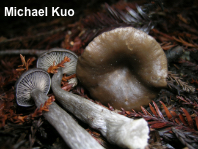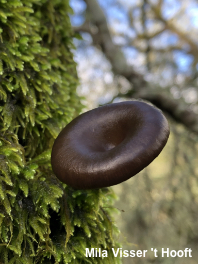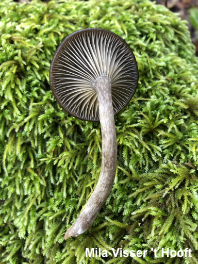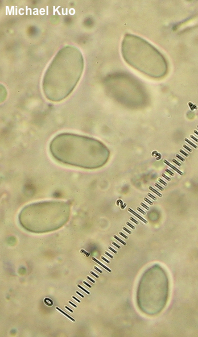| Major Groups > Gilled Mushrooms > Pale-Spored > Clitocyboid Mushrooms > Pseudoclitocybe cyathiformis |

|
Pseudoclitocybe cyathiformis [Basidiomycota > Agaricales > Tricholomataceae > Pseudoclitocybe . . . ] by Michael Kuo A medium-sized clitocyboid mushroom with a dark grayish brown cap that is depressed in the center, Pseudoclitocybe cyathiformis favors mossy stumps and logs and appears in fall or winter, depending on climate. In North America it is distributed in northern, montane, and West-Coast forests. The stem is long in proportion to the cap, and has a streaked and finely ridged appearance. The gills are gray at first, but mature to whitish. In North America Pseudoclitocybe cyathiformis has spores ranging from inamyloid to weakly amyloid, while European collections have more strongly amyloid spores. Thanks to Mila Visser 't Hooft for collecting, documenting, and preserving Pseudoclitocybe cyathiformis for study; her collection is deposited in The Herbarium of Michael Kuo. Description: Ecology: Saprobic; growing alone or gregariously, usually in moss on well-rotted wood but sometimes on the ground in moss or leaf litter; fall, or over winter in warm climates; originally described from France and widely distributed in Europe; in North America widely distributed in northern and montane areas (including the Appalachians), as well as the West Coast and Mexico; also known from Japan. The illustrated and described collections are from California. Cap: 3–5 cm across; planoconvex with a depressed center; bald; moist; dark grayish brown to very dark gray (nearly black), fading to grayish or brownish; margin incurved when young. Gills: Beginning to run down the stem; close or nearly distant; short-gills frequent; grayish, becoming paler with age. Stem: 5–8 cm long; up to about 1 cm thick; more or less equal; bald, or finely fibrillose in places; mottled gray and whitish; finely lined longitudinally; hollowing; basal mycelium white. Flesh: Insubstantial; watery grayish; not changing when sliced. Odor: Somewhere between mealy and "green corn"; rehydrated material with a strongly spermatic odor. Chemical Reactions: KOH negative on cap surface. Microscopic Details: Spores 7–12 x 4.5–6.5 µm; ellipsoid to broadly ellipsoid, with a small apiculus; smooth; hyaline in KOH; inamyloid or weakly amyloid. Basidia 30–38 x 5–7.5 µm; subclavate; 4-sterigmate. Hymenial cystidia not found. Pileipellis a tangle of smooth, hyaline elements 5–7.5 µm wide. Clamp connections not found. REFERENCES: (Bulliard, 1786) Singer, 1956. (Kauffman, 1918; Harmaja, 1974; Phillips, 1981; Bigelow, 1985; Arora, 1986; Breitenbach & Kränzlin, 1991; Kuyper, 1995; Buczacki et al., 2012; Desjardin, Wood & Stevens, 2014; Siegel & Schwarz, 2016; Gminder & Böhning, 2017; Alvarado et al., 2018; Knudsen, 2018; Læssøe & Petersen, 2019.) Herb. Kuo 01130513, 01262002. This site contains no information about the edibility or toxicity of mushrooms. |
© MushroomExpert.Com |
|
Cite this page as: Kuo, M. (2020, October). Pseudoclitocybe cyathiformis. Retrieved from the MushroomExpert.Com Web site: http://www.mushroomexpert.com/pseudoclitocybe_cyathiformis.html |



 Spores
Spores